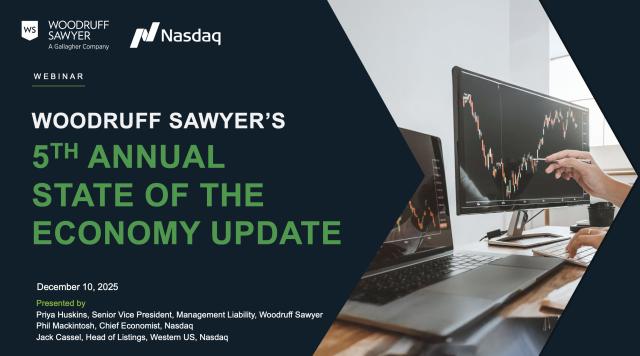Blog
D&O Risk and Insurance in a Post-Chevron World
Big deal or not a big deal? In this week’s edition of the D&O Notebook, my colleagues Walker Newell and Teresa Milano break down the demise of the Chevron doctrine and its implications for directors, officers, and the companies they serve. –Priya
To modify an old saying: “Nothing is certain but death, taxes...and corporate opposition to government regulations.”
Over the decades, companies and interest groups have frequently challenged government regulations in court—and they are successful about 30% of the time.
In recent years the Securities & Exchange Commission (SEC) has been aggressive in its rule making, and public companies have been aggressive in challenging these rules. Many of these legal challenges have resulted in the courts striking down new rules, removing what would have otherwise been significant ongoing disclosure and compliance items for public companies. The hit list includes:
- The share buyback rules (struck down)
- The climate disclosure rules (stayed)
- The private fund adviser rules (struck down)

While companies and interest groups have had considerable success throttling the acceleration of the regulatory state in recent years, government agencies still had the benefit of a dusty Reagan-era doctrine known as Chevron deference. That is, until June 2024, when the Supreme Court sent Chevron down to the junkyard of history like a rusty old Datsun.
What implications will the demise of Chevron deference have on regulatory and litigation risk for directors and officers? What about impacts to insurance? Let’s discuss.
A Quick Primer on the Administrative State
Before digging into the Supreme Court’s Chevron decision, a quick review of our domestic system of administrative law will provide some context.
Statutes passed by Congress typically create big ambiguous high-level frameworks. Statutes are rarely all that specific, and they typically endow federal agencies with the authority not just to enforce the statute but also to make rules to fill in the detail gaps.
When rules and regulations are proposed by agencies, there’s a public notice and comment period, and then the agency adopts the rules. Once the rules are adopted, they have the force of law, businesses have to comply, and agencies can penalize non-compliance.
An advocate of federal rulemaking would say that Congress can’t possibly provide enough detail in statutes to effectively create the types of laws needed to regulate complex 21st century industry. And, unlike Congress, agencies have specific expertise in their field because they focus on a particular industry or issue (financial services, food and drug, environmental safety, etc.).
A critic of federal rulemaking would say that agencies have gone overboard on many occasions over the years, overstepping the grant of authority from Congress and usurping the role of the legislature. Critics also point out that agencies are populated by unaccountable bureaucratic staffers, rather than elected officials who disgruntled voters can theoretically replace.
This argument has been raging in legal circles for a very long time. For decades, the Supreme Court and many federal courts were mostly composed of judges who believed that, on balance, federal agencies and rules serve an important purpose and that our system of administrative law works pretty well. But that balance has been shifting, and a majority of the current Supreme Court now has a different view of the administrative state.
Chevron Spills
A bit more history before turning to the Chevron doctrine. The Administrative Procedure Act (APA) is a 1946 law which governs how federal agencies can pass rules and also has some language on judicial review of statutes. Folks challenging federal regulations in court often invoke the APA, saying that regulators have not engaged in the right process or have overstepped their authority.
That gets us to the Chevron decision. Handed down in 1984, Chevron held that when a federal court is considering a challenge to an agency action, the first step is to discern “whether Congress ha[d] directly spoken to the precise question at issue.” The Court explained that “[i]f the intent of Congress is clear, that is the end of the matter,” and courts should “reject administrative constructions which are contrary to clear congressional intent.” But when “the statute [was] silent or ambiguous with respect to the specific issue,” a court could not “simply impose its own construction on the statute, as would be necessary in the absence of an administrative interpretation.” The court had to defer to the agency’s “permissible construction of the statute,” even if the court would have reached a different result starting from scratch.
For decades, Chevron was a powerful weapon in the arsenal of federal agencies defending against legal challenges to rulemaking. However, in recent years, it had been increasingly clear that the doctrine was under assault. And in the Loper Bright Enterprises v. Raimondo case this June, the Supreme Court struck down the doctrine entirely.
At a high level, the majority of the court said that Chevron was inconsistent with the APA because the APA has language indicating that courts should “interpret...statutory provisions.”
Note: the dissent strenuously disagreed with this interpretation.
Even more fundamentally, the Court said “agencies have no special competence in resolving statutory ambiguities. Courts do.” Going forward, federal courts “must exercise their independent judgment” and “may not defer to an agency interpretation of the law simply because the statute is ambiguous.”
Chevron’s Impact: Big Deal or Not a Big Deal?
As the majority pointed out in Loper, the question of whether a statute is ambiguous on a particular issue is often quite hazy and subjective. As a result, if you were a federal judge faithfully applying Chevron and looking at a particular agency rule that may or may not have been authorized by a statute, you would probably err on the side of letting the rule stand.
So how impactful, really, is Chevron’s demise going to be? There are different schools of thought.
First, at a baseline level, there is consensus that it’s just plain easier now to challenge administrative rules than it was before Loper. If you are a company or corporate interest group thinking about filing a challenge, your likelihood of success has gone up. With better odds, we are now likely to see even more challenges to federal agency actions.
| In the dissent, Justice Elena Kagan articulated her view of the significance of the decision: |
| It gives courts the power to make all manner of scientific and technical judgments. It gives courts the power to make all manner of policy calls...It puts courts at the apex of the administrative process as to every conceivable subject—because there are always gaps and ambiguities in regulatory statutes, and often of great import. What actions can be taken to address climate change or other environmental challenges? What will the Nation’s health-care system look like in the coming decades? Or the financial or transportation systems? What rules are going to constrain the development of A.I.? In every sphere of current or future federal regulation, expect courts from now on to play a commanding role. |
That sure sounds like a big deal.
Another school of thought holds that the Loper decision was significant but will not fundamentally transform the relationship between the courts and regulators. Not every challenge to federal rules involved Chevron analysis. And, because Chevron was very clearly under threat in recent years, agencies lately have already been relying less on the doctrine than in the past. Proponents of this way of thinking also point out that Loper leaves undisturbed judicial deference to agency rulemaking based on factual determinations and technical judgments, where there is a clear delegation from Congress. So, while Loper may be impactful in some cases, in many cases it won’t be.
There are good arguments on both sides, but we tend to fall more in the big deal camp. Judicial doctrines are important. Just as important? The tone that the Supreme Court sets for lower courts, particularly those that may be predisposed to skepticism toward the administrative state. When the Supreme Court throws out a 40-year-old decision that was a foundational building block of administrative law, this may embolden lower court judges to make similarly bold rulings. And, as discussed, even before Loper, the SEC and other federal agencies were already under significant pressure from successful court challenges. The decision suggests that these trends will only intensify.
Impact on Regulation, Litigation, and Insurance
The Loper story will play out over the course of decades, and it’s impossible to predict the decision’s exact ramifications. But here are a few general predictions:
- Companies and interest groups will feel increasingly emboldened to support challenges to agency rules. Such challenges, however, will not be without risk (see below).
- Agencies will be forced to be more circumspect about what rules to pass, how to frame them, and what factfinding to conduct. They will engage in a more resource-intensive process. Even with that resource-intensive process, though, agencies will face significant risk that a court will disagree. Also, agency resources will be increasingly snarled in court to defend new regulations. Assuming equal resourcing, this could give agencies less time to focus on other regulatory activities.
- The regulatory burden on companies is likely to lighten in the near term, as new rules face continued aggressive challenges and existing rules face new challenges. Over the medium term, it is unclear how Loper will affect the balance of power between industry and regulators. In theory, the decision is value-neutral, so theoretically it could be used by pro-regulation actors, too.
- The potential demise of new rules will create uncertainty and compliance conundrums for management teams. If it’s impossible to predict how courts will respond to any given challenge, you can’t plan for a judge to save your company from compliance with a new requirement. Instead, companies will have to prepare to comply with new regulations, while simultaneously preserving optionality if the courts later step in.
Over a long time horizon, the demise of Chevron has the potential to translate into a materially gentler regulatory environment for companies, directors, and officers. In addition to rulemaking, regulatory enforcement actions and litigation may be affected, especially in more aggressive areas.
Private litigation, however, should be largely unimpacted by the decision—and these are the claims that drive the most significant financial D&O risks. At least for now, the Supreme Court is not riding to the rescue when it comes to shareholder litigation.
From an insurance perspective, less regulation and less government litigation could contribute to lower insurance carrier losses, which could in turn slowly contribute to better pricing and terms over a period of many years. But any such changes are going to be hard to measure and at the margins.
Also, like the stock market, management teams, boards, and presumably insurance underwriters like stability and certainty. An uncertain regulatory environment may be challenging for some companies to navigate, potentially contributing to missteps in business planning, which can in turn drive shareholder claims.
In the end, the only certain thing is that regulatory uncertainty will prevail. Will this be a materially good thing for D&O risk? That remains to be seen.
Author
Table of Contents











